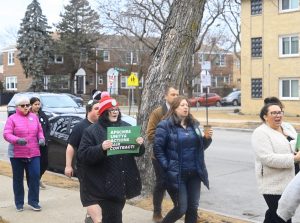Student green fee helping global climate
What NEIU does to be more eco-friendly
October 8, 2019
Between Sept. 20-27, over 7.6 million people in 185 countries around the globe took to the streets in defense of the future during the Global Climate Strike.
In the U.S., the organization Sunrise Movement has pushed climate change into headlights of the 2020 Presidential elections with the Green New Deal. Introduced by New York Rep. Alexandria Ocasio – Cortez on Feb. 7, the Green New Deal is a program designed to tackle climate change in a 10 year plan.
Here at Northeastern Illinois University (NEIU), the Green Fee is a $3 fee that every student pays each semester they are enrolled.
This small amount of money supports the accordingly named Green Fee Committee, which is a volunteer on-campus organization designed to “incorporate and help fund initiatives that reduce energy, water usage and waste on campus” according to NEIU’s website.
NEIU didn’t always have a Green Fee. According to Dr. Alex Peimer, the idea for the Green Fee originated in the Green Cycle Group (which is now the Green Conservation Group) in 2007.
This student club took initiative and pitched the idea of the Green Fee to the Student Government Association (SGA), who then approved said fee. The Green Fee Committee was formed soon after and meets to decide how to use the money collected from the fee, utilizing NEIU community suggestions and current trends in campus ecological technology.
Currently, the Green Fee Committee consists of nine volunteer members: four faculty/staff, a Student Government Association representative, an at-large student representative, one student representative from the Department of Geography and Environmental Studies, and two student representatives from the Green Conservation Group.
The Green Fee Committee has funded dozens of projects since its inception. NEIU is privileged to have water bottle fill fountains that dispense clean water into reusable water bottles.
Bike racks are scattered around campus, offering a place to secure an ecologically-friendly bicycle. A bike repair station helps cyclists keep their ride in good working order.
PDF scanners at the library let students scan pages of their textbook into a digital file instead of printing them out. There are two solar power banks providing power to the Physical Education and B buildings at the Main Campus.
Solar panels have also recently been installed at the Jacob H. Carruthers Center for Inner City Studies (CCICS). In 2015, NEIU also installed electric car chargers on the first floor of the parking garage to encourage more sustainable vehicle usage.
On the arboreal side of the Green Fee Committee projects, removing invasive species from the remnant swamp white oak savanna vegetation (located next to PE building) helps support species diversity and creates a green corridor for animals to use.
Planting native species in and around campus not only provides pretty plants to look at but makes maintenance of the grounds less labor and water intensive.
Being part of the Green Fee Committee or other environmental groups is not the only way to contribute to a greener environment on campus.
While all students are contributing by paying the $3 Green Fee, there are a number of easy ways students can take initiative and reduce waste and consumption.
Bringing reusable coffee cups or a thermos to Café Descartes to purchase a refill coffee is an easy way to save hundreds of pounds of paper waste from going to the landfill, and is even less expensive.
Using e-readers or doing student readings on a laptops, or even just by using both sides of the paper when printing, countless trees can be saved from becoming paper waste. These every day actions that seem inconsequential have an impact.
Thanks to the Green Fee Committee, NEIU is a much more sustainable campus than it was in 2007.







